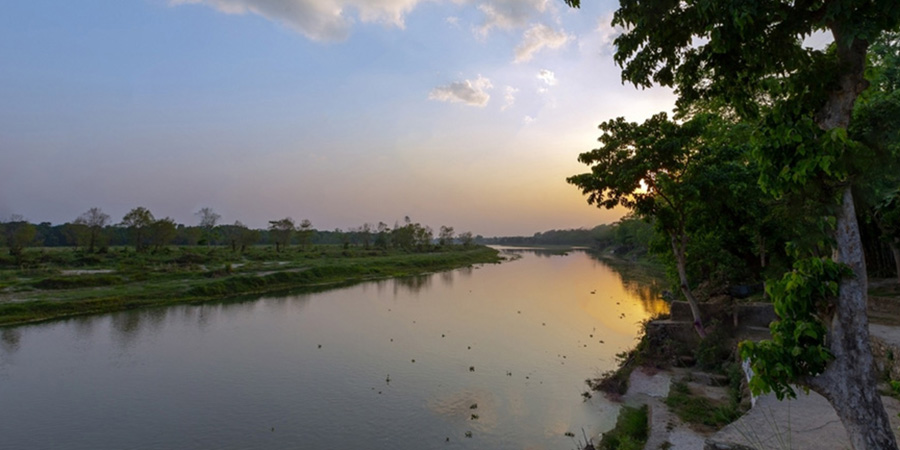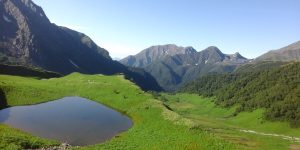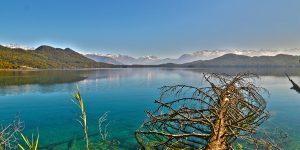A recent visit to Middle Rapti gave me a different perspective on socio-economic development. It provided an interesting observation on the virtual presence of the government and the consequences of haphazard urbanization. Often, we argue that the construction of infrastructure (especially road infrastructure) is necessary for the development of economies. While there is no denying that developing infrastructure is a must for development, it is equally important to consider the environmental consequences of development. For this reason, the convoluted relationship between urbanization and the environment must be well understood. For instance, unplanned construction of roads can have adverse effects on river watersheds, aquatic habitats and ecological biodiversity.
Haphazard construction of roads can significantly increase the risk of floods. Kanchi Gaun , a village in Dang, was completely displaced by extensive floods that occurred in the Rapti River in FY 2006/07. The floods resulted from unruly extraction of aggregates from nearby hills and rivers, which caused the Rapti River to change its course. Likewise, unplanned extraction of aggregates as also impacted watersheds, aquatic biodiversity and the livelihood of farmers. Random fluctuation in water levels has been cited as a primary reason for changes in aquatic habitat resulting in decreased biodiversity. A fisherman I spoke to lamented that it had become difficult for him catch fish these days. Recounting his childhood days, he mentioned that he would catch fish of up to five kilograms in an hour.
Further explaining his plight, he mentioned how declining fish numbers had not only impacted the livelihood of fishermen, but also local ecological diversity. Migrating birds that once used to charm Rapti no longer visit the region and crocodiles that would once sunbathe by the banks are on the verge of extinction. A visit to the community forest provided visual evidence of the intricate relationship between disorganized economic development and the environment.
Before, I would prioritize economic development and urbanization above everything else. Witnessing the tangible impact rampant deforestation had on Gurung Khola and the community that relied on the river for their livelihood gave me a rude awakening. Gurung Khola used to be the main source of water for nearby villages, but due to rampant deforestation is now only a phantom river—containing not a drip of water. Fortunately, the so-called ‘illiterate’ villagers have started a strong campaign against deforestation hoping to revive the once vibrant river.
It was also surprising to learn that irrigation projects could be self-defeating if environmental concerns are not taken into account. Usually, if an economist is asked about the ways in which agriculture productivity and income of farmers can be increase, their solution would probably be to build mega irrigation facilities. One of the locals, however, explained that the development of irrigation facilities such as Badkapath and Pragana in Dang district can be counterproductive as they have been constructed without consideration of the environment. He further explained that due to the continuous exploitation of minerals from Rapti and its subsidiary rivers, water levels will decrease and the irrigation projects will fail to serve their purpose.
My visit to Sitalapur, a Dalit village in the hinterland of Dang gave me the opportunity to further explore contemporary socio-economic issues. The village still relies on kanika (rice grits) as their main source of food and education is a luxury only few can afford. One of the villagers revealed that when he was younger, he would walk two hours to reach his primary school. His son, 20 years later, is doing the same. Nothing has changed. But hearing the student choir sing ‘sayaun thunga full ka hami eutai mala Nepali’, I was reminded of their unrelenting faith towards their motherland. One of the local farmers also explained to me the economic importance of Rs. 3,000. With this amount, he could buy a piglet, which could fetch around Rs. 30,000 within six months. For those who reside in Kathmandu, where a single visit to a cinema theater can cost up to Rs.3000, it is hard to imagine that the amount can significantly change livelihoods.
Nevertheless, villagers also shared stories regarding the positive impact of a watershed built in their locality. When I inquired about who funded the watershed the villagers told me the fund was provided by a foreign entity instead of the Government of Nepal. I turned to my colleague to verify the veracity of this claim. He nodded in dismay and said that it is was the Kuwait government who had funded the watershed project. What about the community forest? It was completed by the villagers in collaboration with different international non-governmental organizations. And who are the ones extracting minerals from the rivers and hills? Local politicians.
By the time my excursion came to an end, my perspective on economic development had undergone a significant transformation. I was left with many thought-provoking questions regarding socio-political issues. While most Nepali citizens are still struggling to fulfill their basic needs, state officials continue to be lured into purchasing luxury cars and helicopters. I could not grapple with the extravagant spending capacity of civil servants, especially having seen how relatively smaller amounts of money can produce visible change for an entire community. For the cost of a luxury car, subsidies of Rs. 3,000 could change the livelihood of 50,000 farmers. I hope our government officials reflect on their capacity to enact change rather than pocket it. A version of this article first appeared in The Kathmandu Post on 6 January 2018.











